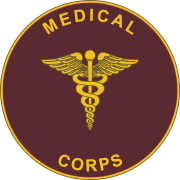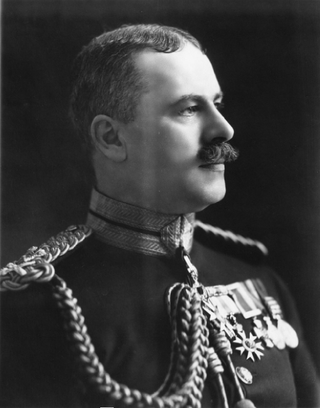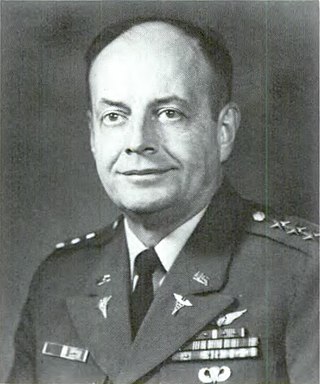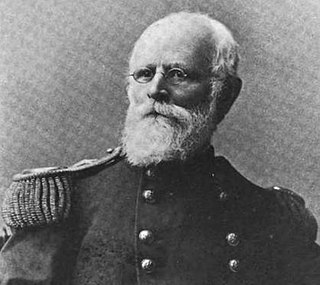Reference
- 1 2 3 "Lieut. Colonel Frank B. Hines, M.D., N.G.". The Military Surgeon. 107 (3): 253. September 1950. doi:10.1093/milmed/107.3.251.
- ↑ "Dr. Hines, Shore Physician, Dies". Evening Sun. Baltimore, MD. March 28, 1950. Retrieved May 5, 2024.
Frank Brown Hines (June 24, 1881 - March 26, 1950) was an American physician and military officer. Hines graduated from the College of Physicians and Surgeons, Baltimore in either 1906 or 1904. [1] [2] In 1917, Hines joined the Maryland National Guard as a first lieutenant. [1] He served in France as part of the 29th Infantry Division during World War I and was promoted to Captain. In 1922, he became as the regimental surgeon and was further promoted to Major and then Lieutenant colonel. [1]

Lieutenant-General Sir Alfred Henry Keogh, was a medical doctor in the British Army. He served as Director-General Army Medical Services twice; from 1905 to 1910 and 1914 to 1918.

The Medical Corps (MC) of the U.S. Army is a staff corps of the U.S. Army Medical Department (AMEDD) consisting of commissioned medical officers – physicians with either an M.D. or a D.O. degree, at least one year of post-graduate clinical training, and a state medical license.

John Moore, MD was a leading United States Army physician during the American Civil War who rose to become Surgeon General of the Army in the late 1880s.

Major-General Sir Marie-Joseph-Eugène Fiset, was a Canadian physician, military officer, Deputy Minister of Militia and Defence, Member of Parliament, the 18th Lieutenant Governor of Quebec, and the 3rd Canadian Surgeon General.

Henry Crécy "H. C." Yarrow was an American ornithologist, herpetologist, naturalist, and surgeon.

Alexander Thomas Augusta was a surgeon, veteran of the American Civil War, and the first African-American professor of medicine in the United States. After gaining his medical education in Toronto, Canada West from 1850 to 1856, he set up a practice there. He returned to the United States shortly before the start of the American Civil War.

Hal Bruce Jennings, Jr. was an American plastic surgeon who served as Surgeon General of the United States Army from October 10, 1969, to September 30, 1973.

The Indian Medical Service (IMS) was a military medical service in British India, which also had some civilian functions. It served during the two World Wars, and remained in existence until the independence of India in 1947. Many of its officers, who were both British and Indian, served in civilian hospitals.

Charles Calvin Pixley was the 34th Surgeon General of the United States Army, serving in that capacity from October 1, 1977, to September 20, 1981.

The physician to the president is the formal and official title of the physician who the president of the United States chooses to be their personal physician. Often, the physician to the president also serves as the director of the White House Medical Unit, a unit of the White House Military Office responsible for the medical needs of the president of the United States, vice president, White House staff, and visitors. The physician to the president is also the chief White House physician.

Colonel John Leonard Hines Jr. was an officer in the United States Army and the son of General John L. Hines.
The Surgeon General is the professional head of the Canadian military health jurisdiction, the adviser to the Minister of National Defence and the Chief of Defence Staff on all matters related to health, and head of the Royal Canadian Medical Service. The Surgeon General may also be appointed the commander of the Canadian Forces Health Services Group, which fulfils all military health system functions from education and clinical services to research and public health. It consists of the Royal Canadian Medical Service, the Royal Canadian Dental Corps, personnel from other branches of the armed forces, and civilians, with health professionals from over 45 occupations and specialties in over 125 units and detachments across Canada and abroad. When appointed Director General Health Services, the Surgeon General is also the senior health services staff officer in the Department of National Defence. The Surgeon General is normally appointed to the Medical Household as Honorary Physician (KHP) or Honorary Surgeon (KHS) to His Majesty the King.

Lieutenant Colonel Sir Herbert Lightfoot Eason CB, CMG, MD, MS, FRCS. ) was an ophthalmic surgeon who served in the Great War as a Lieutenant Colonel and Consultant Surgeon to the Forces in Egypt and at Gallipoli. He was appointed Superintendent at Guy's Hospital, London, in 1920, Vice Chancellor from 1935 to 1937 of the University of London. President of the General Medical Council from 1939 and was Knighted in 1943 for his services to medicine.
Sir Frank Arnold Gunasekera, CBE, ED was a Ceylonese physician and surgeon. He was elected a Deputy President of the Senate of Ceylon in 1948.

Jedediah Hyde Baxter was a career United States Army officer and doctor who attained the rank of brigadier general as Surgeon General of the United States Army.
The 1902 Coronation Honours were announced on 26 June 1902, the date originally set for the coronation of King Edward VII. The coronation was postponed because the King had been taken ill two days before, but he ordered that the honours list should be published on that day anyway.
Henry MacCormac, M.B, Ch.B, F.R.C.P., CBE, (1879-1950), was a notable dermatologist in Britain during the early twentieth century. MacCormac was a member of a distinguished medical family that included Henry MacCormac and Sir William MacCormac. Henry MacCormac also served as a captain in the Royal Army Medical Corps during the First World War.
The King's Birthday Honours 1950 were appointments in many of the Commonwealth realms of King George VI to various orders and honours to reward and highlight good works by citizens of those countries. The appointments were made to celebrate the official birthday of the King, and were published in supplements to the London Gazette of 2 June 1950 for the British Empire, Australia, Ceylon and New Zealand.

Robert Murray was a physician and career officer in the United States Army. He attained the rank of brigadier general, and served as Surgeon General of the United States Army from 1883 to 1886.From 1910 to 1911 he was vice president,from 1911 to 1912 president of the Aztec Club of 1847.

John Meck Cuyler, M.D. was an American Brevet Brigadier General and military physician. He was the Medical Inspector throughout the American Civil War, notable for his service at the II Corps camp during the Battle of Gettysburg.